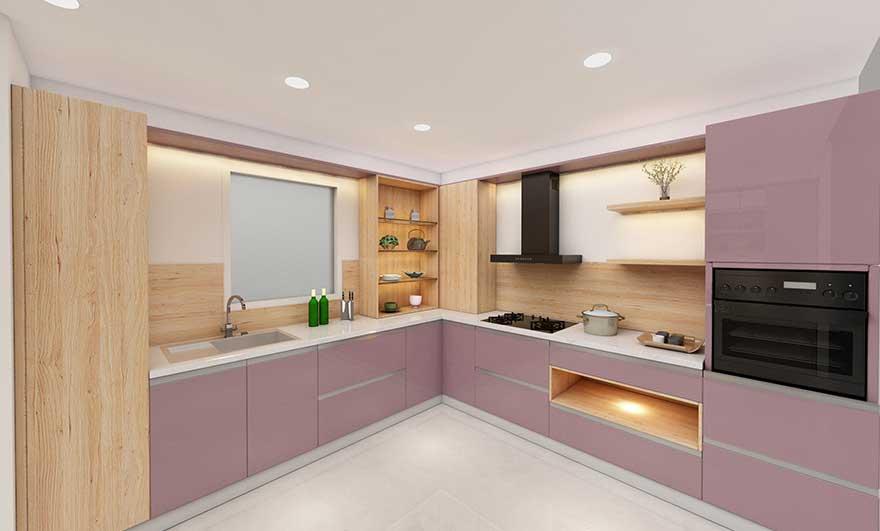Kitchen Design Secrets That Maximize Space and Functionality

Designing a kitchen is more than just arranging cabinets, counters, and appliances. It is about creating a space where functionality meets style, making every corner useful and efficient. In today’s homes, especially where space may be limited, kitchen design plays a crucial role in shaping how effectively the area can be used. A well-planned design not only enhances the look of the kitchen but also ensures smooth workflow, convenience, and comfort for everyday use.
Understanding the Importance of Space Efficiency
Space efficiency is one of the most critical aspects of kitchen design. A poorly designed kitchen often feels cluttered, making cooking and organizing stressful. On the other hand, a carefully planned layout makes even compact kitchens feel spacious and easy to navigate. The goal is to maximize every inch of available space without compromising on aesthetics. This is why modular kitchen concepts have become increasingly popular. A modular kitchen is designed with pre-made cabinet units and functional modules that can be customized according to the needs of the user, offering both efficiency and elegance.
Choosing the Right Layout
The layout forms the foundation of any kitchen design. Whether it is a small apartment or a large home, the right layout can determine how practical the kitchen feels. Popular layouts include L-shaped, U-shaped, parallel, and island kitchens. Each has its own benefits depending on the available space. For smaller kitchens, a parallel or L-shaped layout works best as it utilizes walls efficiently while leaving enough open space for movement. Larger spaces can accommodate U-shaped or island layouts, which provide extra storage and countertop area. Modular kitchen designs allow flexibility in choosing layouts that fit specific requirements.
Optimizing Storage Solutions
Storage is often the most challenging part of kitchen planning. Cabinets, drawers, and shelves should be designed to make the best use of vertical and horizontal space. Tall cabinets can be used to store rarely used items, while pull-out drawers ensure easy access to everyday essentials. Corner spaces, which are often neglected, can be transformed into functional storage units with carousel systems or L-shaped racks. A modular kitchen makes this process simpler with its pre-designed storage solutions that can be adjusted and arranged to meet individual preferences.
Smart Use of Countertops
Countertops are the most used surfaces in a kitchen, and their design can impact both functionality and aesthetics. Having a continuous and clutter-free countertop allows smooth workflow while preparing meals. Materials like granite, quartz, and solid surfaces are preferred for their durability and easy maintenance. Incorporating adequate under-counter storage helps keep countertops free from unnecessary items. In modular kitchen setups, countertops can be customized to include built-in appliances like stovetops and sinks, which save space and create a seamless design.
The Role of Lighting in Kitchen Design
Lighting is often underestimated but plays a significant role in maximizing space and functionality. A well-lit kitchen not only looks more spacious but also ensures safety while cooking. Task lighting above counters and stovetops improves visibility, while ambient lighting enhances the overall atmosphere. Under-cabinet lights are particularly useful in modular kitchens as they brighten up work areas without taking up extra space. Natural light should also be maximized by planning windows or open layouts whenever possible.
Integrating Appliances Seamlessly
Modern kitchens rely heavily on appliances, but without proper planning, they can take up too much space and disrupt workflow. Built-in ovens, microwaves, and refrigerators offer a neat solution as they integrate seamlessly into cabinets and walls. This not only saves space but also enhances the overall design. In compact spaces, multi-functional appliances such as combination ovens or washer-dryer units are practical choices. A modular kitchen accommodates integrated appliances easily, ensuring they blend with the overall design instead of standing out as bulky additions.
Designing for Movement and Flow
One of the essential kitchen design secrets lies in the concept of workflow. The kitchen should be designed to allow smooth movement between different zones, typically referred to as the work triangle — the stove, sink, and refrigerator. If these three points are placed too far apart, cooking becomes inconvenient. If they are too close, the area feels cramped. Maintaining the right balance ensures maximum efficiency. Modular kitchen layouts are often designed with this principle in mind, making them ideal for both small and large spaces.
Creating Multi-Functional Spaces
Modern kitchens are not just for cooking. They often double as dining areas, workstations, or family gathering spots. Designing multi-functional spaces within the kitchen makes it more versatile. A breakfast counter or island can serve as a dining spot as well as an extra work surface. Open shelving can display décor items, adding character without sacrificing storage. Modular kitchens offer flexibility in incorporating such features, making them adaptable to the changing needs of families.
Incorporating Ergonomics into Design
Ergonomics is another secret to achieving functionality in kitchen design. The height of countertops, placement of cabinets, and accessibility of appliances should all be planned with user comfort in mind. Cabinets should not be too high or too deep, and heavy appliances should be positioned at waist level for ease of use. Proper ergonomics reduces strain and makes daily tasks more comfortable. Modular kitchen systems are often designed with ergonomic principles, ensuring that functionality aligns with comfort.
Balancing Aesthetics with Practicality
While functionality is the priority, aesthetics should not be overlooked. A beautiful kitchen enhances the overall appeal of a home and makes spending time in it enjoyable. Choosing the right colors, finishes, and materials contributes to a pleasant environment. Light shades make small kitchens appear more spacious, while bold tones can add personality to larger ones. Open shelving, glass-front cabinets, and stylish hardware can also uplift the look. The advantage of a modular kitchen is that it combines practical features with a wide range of design choices, ensuring that the final outcome is both stylish and functional.
The Future of Kitchen Design
As lifestyles evolve, kitchens are becoming smarter and more efficient. The integration of technology such as motion-sensor faucets, smart lighting, and app-controlled appliances is shaping the kitchens of tomorrow. Space-saving innovations and sustainable materials are also gaining popularity. Modular kitchen designs are at the forefront of this evolution, offering the flexibility to adapt to new trends while maintaining timeless functionality.
Conclusion
Maximizing space and functionality in kitchen design requires thoughtful planning and innovative solutions. From choosing the right layout to optimizing storage, integrating appliances, and ensuring ergonomic comfort, every detail matters. A modular kitchen offers the perfect blend of efficiency, style, and adaptability, making it a practical choice for modern homes. By applying these design secrets, homeowners can create kitchens that not only look beautiful but also make everyday life smoother and more enjoyable.








